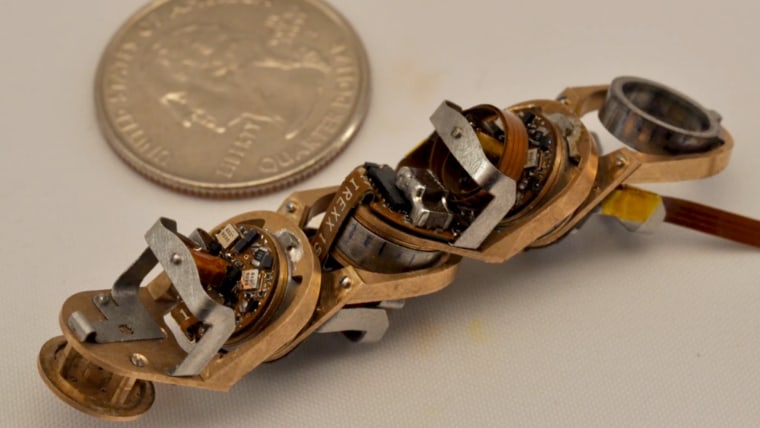
Imagine a string that can assemble itself into just about anything wherever and whenever you need it — a wrench to adjust your child’s bike seat or a hammer to pound a nail into the wall, for example. That future may be distant, but researchers have built a robot that already hints at the possibility.
“The robot is just a continuous strip, it is a one-dimensional thing,” Neil Gershenfeld, director of the Center for Bits and Atoms at the Massachusetts Institute of Technology, told NBC News, speaking of the concept behind the device.
“It is a continuous strip that … gets folded into the shapes you want it to make. This is a kind of robot that you can produce in a continuous process. You can produce it by the mile; it is not assembling a bunch of separate parts.”
The robot is called a milli-motein, because it is a small "mechanical protein," inspired by the organic molecules that naturally fold themselves into complex shapes.
On the software side, the robot has a math piece that turns code into shapes, the architecture that allows a one-dimensional robot make any 3-D shape. On the hardware side, it’s got a newly developed motor that’s similar in function to the giant electromagnets that lift scrap metal at the junkyard.
The motors are called electropermanent because, after taking shape, they hold their shape without additional power. This makes them highly energy efficient and ideal building blocks. You can learn more about their function in this video:
In theory, the milli-motein “can make any connected shape,” Gershenfeld told NBC News. However, for now, the robots are made by hand, meaning producing the joints in bulk is a time-consuming process. In addition, the team needs to make each joint stronger so they can support more than one module.
Immediate spinoffs for the technology include using the newly-developed motors in all-electric airplanes “where they’ll move the control surfaces of the airplane but they are automatically safe because they keep their position without power,” Gershenfeld said.
The milli-motein technology could eventually make all robotics cheaper because, instead of making custom robots programmed for specific tasks, “you can just produce this bulk material and use it for applications,” Gershenfeld said.
By the same token, the flexibility of the robots to be any shape desired means they can be reconfigured to do different jobs. “That should, over time, have significant implications on the economics of automation.”
The work was funded by DARPA, the military’s futuristic research arm. Why’s the Pentagon interested in the technology? For one, it should lower the costs of robotics across the board, Gershenfeld said.
“Because robots are so expensive, soldiers can risk themselves to protect the robot.” Ultimately, he said, “you don’t want a robot to cost much more than an improvised road explosive.”
— via The Verge
John Roach is a contributing writer for NBC News Digital. To learn more about him, check out his website. For more of our Future of Technology series, watch the featured video below.